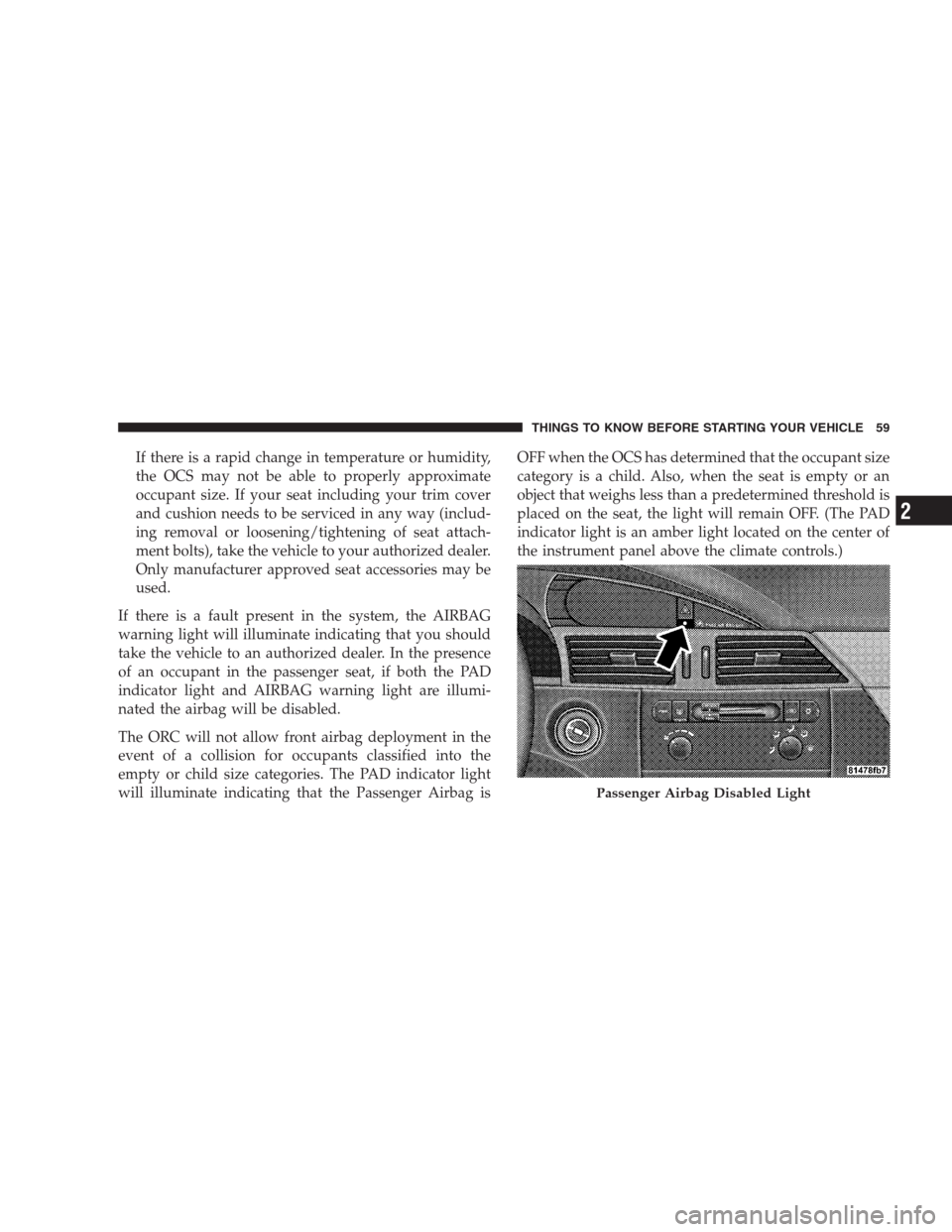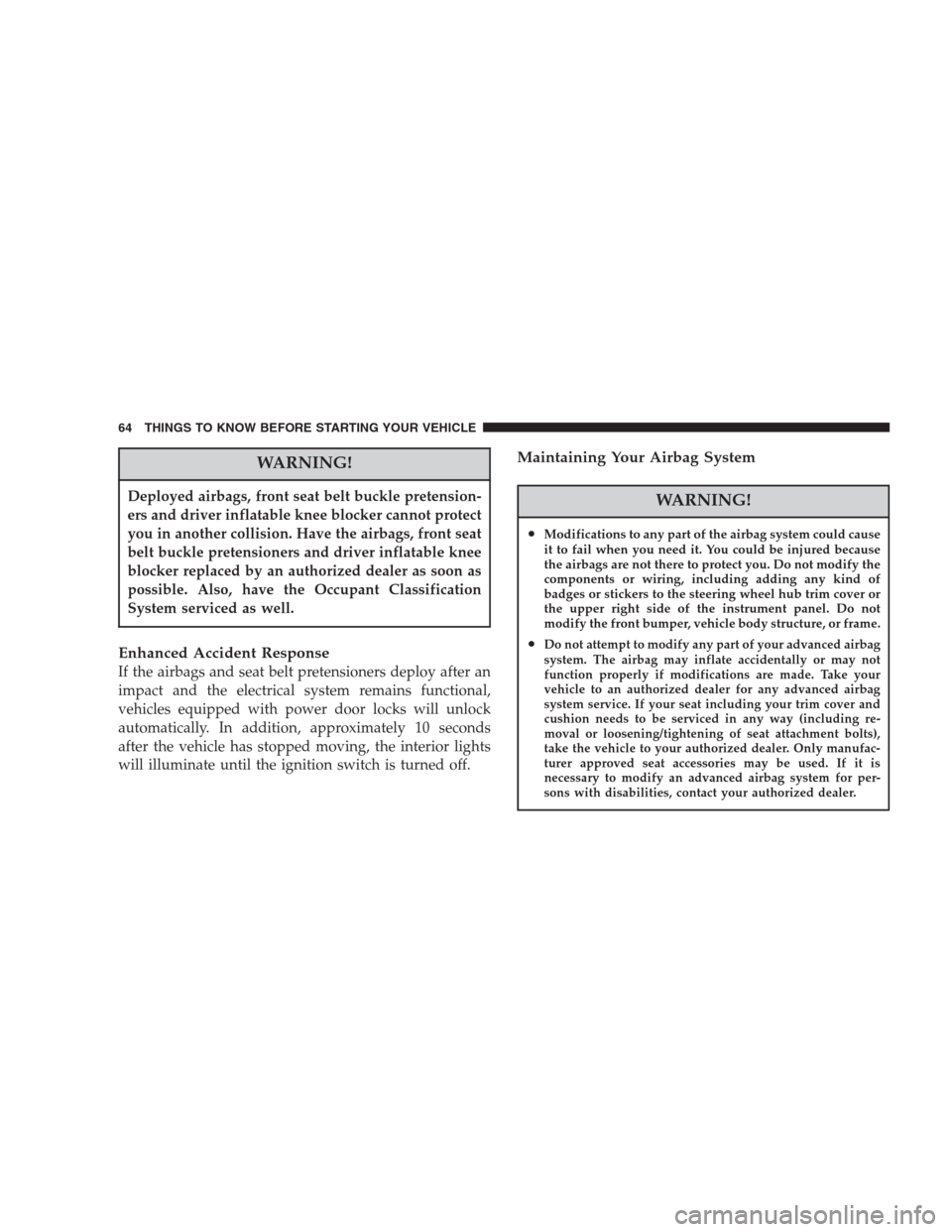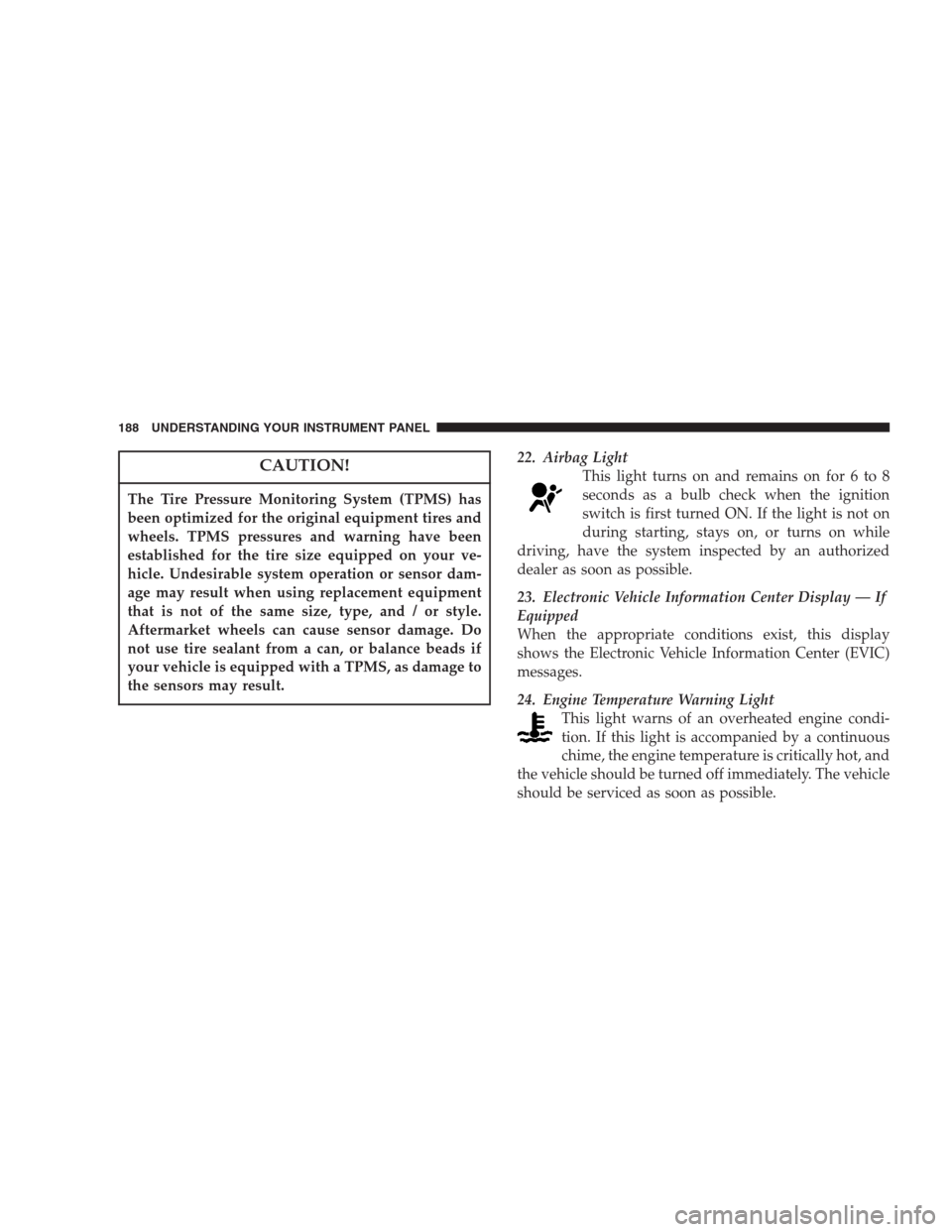airbag off CHRYSLER PACIFICA 2007 1.G Owners Manual
[x] Cancel search | Manufacturer: CHRYSLER, Model Year: 2007, Model line: PACIFICA, Model: CHRYSLER PACIFICA 2007 1.GPages: 464, PDF Size: 5.92 MB
Page 56 of 464

How The Airbag System Works
•
TheOccupant Restraint Controller (ORC)determines
if a frontal collision is severe enough to require the
airbags to inflate. Based on the level of collision
severity, the front control module determines the
proper rate of inflation. The front airbag inflators are
designed to provide different rates of airbag inflation.
•The ORC may modify the rate of inflation based on the
occupant size provided by the Occupant Classification
Module.
•The ORC will not detect side, roll over, or rear impacts.
•The ORC monitors the readiness of the electronic parts
of the system whenever the ignition switch is in the
START or RUN positions. These include all of the
items listed above except the steering wheel andcolumn, instrument panel and passenger knee bol-
sters. If the key is in the OFF position, in the ACC
position, or not in the ignition, the airbags are not on
and will not inflate.
•Also, the ORC turns on the AIRBAG warn-
ing light and PAD indicator light in the
center of the instrument panel for 6 to 8
seconds for a self-check when the ignition is
first turned on. After the self-check, the AIRBAG
warning light will turn off. The PAD indicator light
will function normally (Refer to “Passenger Airbag
Disable (PAD) Indicator Light” in this section). If the
ORC detects a malfunction in any part of the system, it
turns on the AIRBAG warning light either momen-
tarily or continuously. A single chime will sound if the
light comes on again after initial start up.
56 THINGS TO KNOW BEFORE STARTING YOUR VEHICLE
Page 59 of 464

If there is a rapid change in temperature or humidity,
the OCS may not be able to properly approximate
occupant size. If your seat including your trim cover
and cushion needs to be serviced in any way (includ-
ing removal or loosening/tightening of seat attach-
ment bolts), take the vehicle to your authorized dealer.
Only manufacturer approved seat accessories may be
used.
If there is a fault present in the system, the AIRBAG
warning light will illuminate indicating that you should
take the vehicle to an authorized dealer. In the presence
of an occupant in the passenger seat, if both the PAD
indicator light and AIRBAG warning light are illumi-
nated the airbag will be disabled.
The ORC will not allow front airbag deployment in the
event of a collision for occupants classified into the
empty or child size categories. The PAD indicator light
will illuminate indicating that the Passenger Airbag isOFF when the OCS has determined that the occupant size
category is a child. Also, when the seat is empty or an
object that weighs less than a predetermined threshold is
placed on the seat, the light will remain OFF. (The PAD
indicator light is an amber light located on the center of
the instrument panel above the climate controls.)
Passenger Airbag Disabled Light
THINGS TO KNOW BEFORE STARTING YOUR VEHICLE 59
2
Page 60 of 464

For almost all sizes of properly seated adults, the airbag
will be enabled in the event of a collision. For small
teenagers and some small adults, depending on size, the
airbag may or may not be enabled in the event of a
collision. Both drivers and passengers should always use
the PAD indicator light as an indication if the front
passenger is properly positioned or not. If the PAD
indicator light comes on when an adult is in the passen-
ger seat, have the passenger re-position themselves in the
seat until the light goes out.
Remember, if the PAD indicator light is illuminated the
passenger front airbag will not inflate. For almost all
properly installed child restraints, the “PAD Indicator
Light” will be illuminated indicating that the front pas-
senger airbag is turned off and will not inflate. If the
“PAD Indicator Light” is not illuminated, DO NOT
assume the airbag is turned off and move the childrestraint to the rear seat. A deploying passenger airbag
can cause death or serious injury to a child in a rear
facing infant seat.
NOTE:Even though this vehicle is equipped with an
Occupant Classification System, children 12 years and
under should always ride buckled up in a rear seat in an
appropriate child restraint.
•TheOccupant Classification Module (OCM)is lo-
cated beneath the front passenger seat. The OCM
classifies the occupant into one of three size categories
based on the input from the Bladder Assembly and
Belt Tension Sensor. The size categories include empty,
child, and adult. The OCM sends the Occupant Clas-
sification to the ORC to identify if a front passenger
airbag is allowed. If a fault is present, the AIRBAG
warning light is illuminated.
60 THINGS TO KNOW BEFORE STARTING YOUR VEHICLE
Page 61 of 464

•ThePassenger Airbag Disabled (PAD) Indicator
Lightindicates to the driver and passenger when the
airbag is turned OFF in the presence of a properly
seated occupant. When the PAD indicator light is
illuminated, the airbag is OFF. Also, when the Occu-
pant Classification System (OCS) detects either an
empty seat of a weight less than the predetermined
occupant threshold, the ORC will not illuminate the
PAD indicator light even though the airbag is turned
off. When the OCS detects an adult the PAD indicator
light will be off, and the airbag will be enabled.
•TheBelt Tension Sensor (BTS)is located at the
outboard passenger lap belt anchor. The BTS generates
a signal based on outboard lap belt tension. This signal
is sent to the OCM to ensure that the resultant bladder
pressure increase due to applied lap belt tension does
not cause a small occupant to be classified as a larger
occupant.
•TheBladder Assemblyis located beneath the seat
cushion foam. The pressure sensor sends a signal to
the OCM.
The front passenger seat assembly contains critical com-
ponents that affect the front passenger airbag deploy-
ment. Correctly functioning front passenger seat compo-
nents are critical for the Occupant Classification System
(OCS) to properly classify the front passenger and calcu-
late the proper airbag deployment. Do not make any
modifications to the front passenger seat components,
assembly, or to the seat cover.
THINGS TO KNOW BEFORE STARTING YOUR VEHICLE 61
2
Page 64 of 464

WARNING!
Deployed airbags, front seat belt buckle pretension-
ers and driver inflatable knee blocker cannot protect
you in another collision. Have the airbags, front seat
belt buckle pretensioners and driver inflatable knee
blocker replaced by an authorized dealer as soon as
possible. Also, have the Occupant Classification
System serviced as well.
Enhanced Accident Response
If the airbags and seat belt pretensioners deploy after an
impact and the electrical system remains functional,
vehicles equipped with power door locks will unlock
automatically. In addition, approximately 10 seconds
after the vehicle has stopped moving, the interior lights
will illuminate until the ignition switch is turned off.
Maintaining Your Airbag System
WARNING!
•Modifications to any part of the airbag system could cause
it to fail when you need it. You could be injured because
the airbags are not there to protect you. Do not modify the
components or wiring, including adding any kind of
badges or stickers to the steering wheel hub trim cover or
the upper right side of the instrument panel. Do not
modify the front bumper, vehicle body structure, or frame.
•Do not attempt to modify any part of your advanced airbag
system. The airbag may inflate accidentally or may not
function properly if modifications are made. Take your
vehicle to an authorized dealer for any advanced airbag
system service. If your seat including your trim cover and
cushion needs to be serviced in any way (including re-
moval or loosening/tightening of seat attachment bolts),
take the vehicle to your authorized dealer. Only manufac-
turer approved seat accessories may be used. If it is
necessary to modify an advanced airbag system for per-
sons with disabilities, contact your authorized dealer.
64 THINGS TO KNOW BEFORE STARTING YOUR VEHICLE
Page 188 of 464

CAUTION!
The Tire Pressure Monitoring System (TPMS) has
been optimized for the original equipment tires and
wheels. TPMS pressures and warning have been
established for the tire size equipped on your ve-
hicle. Undesirable system operation or sensor dam-
age may result when using replacement equipment
that is not of the same size, type, and / or style.
Aftermarket wheels can cause sensor damage. Do
not use tire sealant from a can, or balance beads if
your vehicle is equipped with a TPMS, as damage to
the sensors may result.
22. Airbag Light
This light turns on and remains on for 6 to 8
seconds as a bulb check when the ignition
switch is first turned ON. If the light is not on
during starting, stays on, or turns on while
driving, have the system inspected by an authorized
dealer as soon as possible.
23. Electronic Vehicle Information Center Display — If
Equipped
When the appropriate conditions exist, this display
shows the Electronic Vehicle Information Center (EVIC)
messages.
24. Engine Temperature Warning Light
This light warns of an overheated engine condi-
tion. If this light is accompanied by a continuous
chime, the engine temperature is critically hot, and
the vehicle should be turned off immediately. The vehicle
should be serviced as soon as possible.
188 UNDERSTANDING YOUR INSTRUMENT PANEL